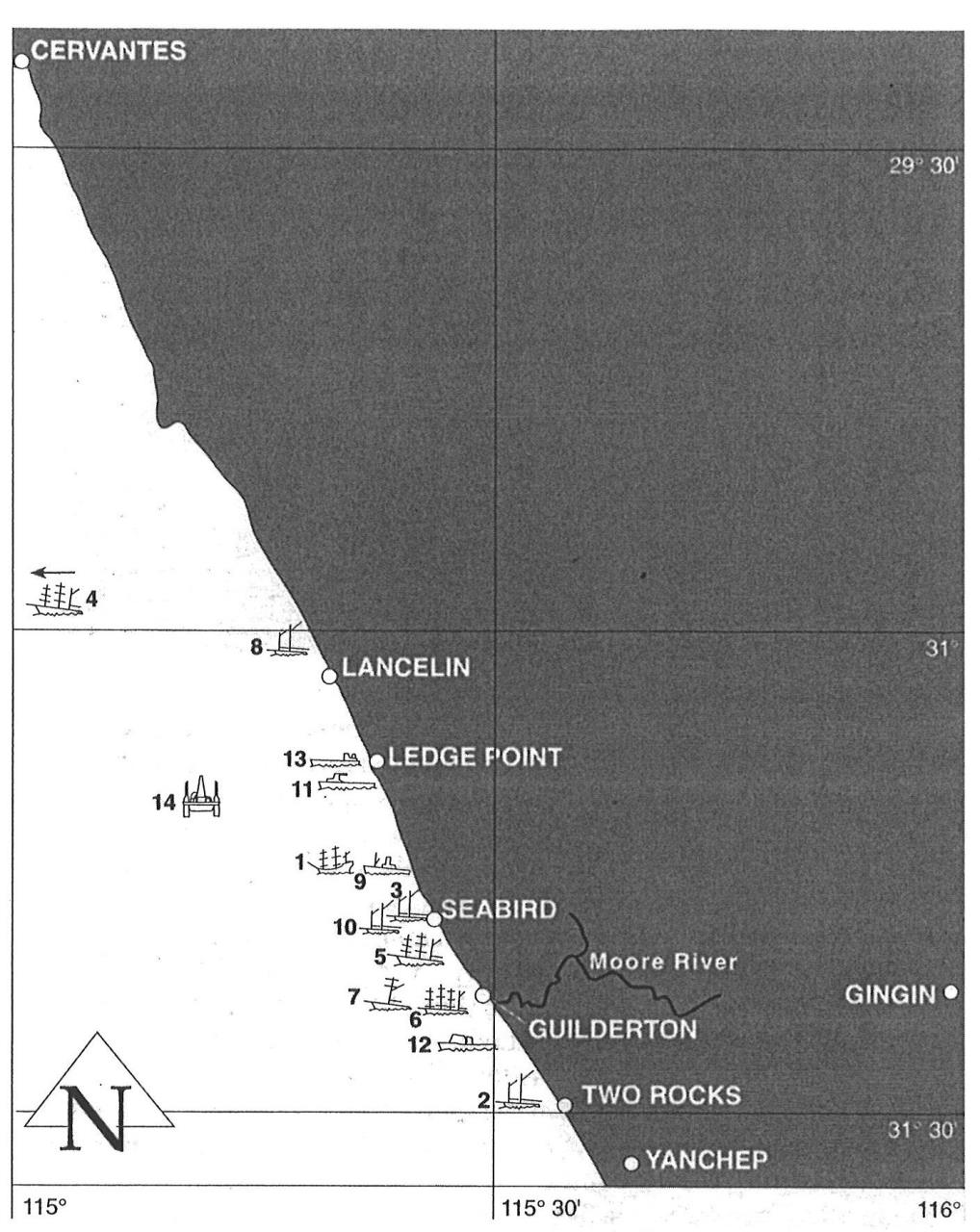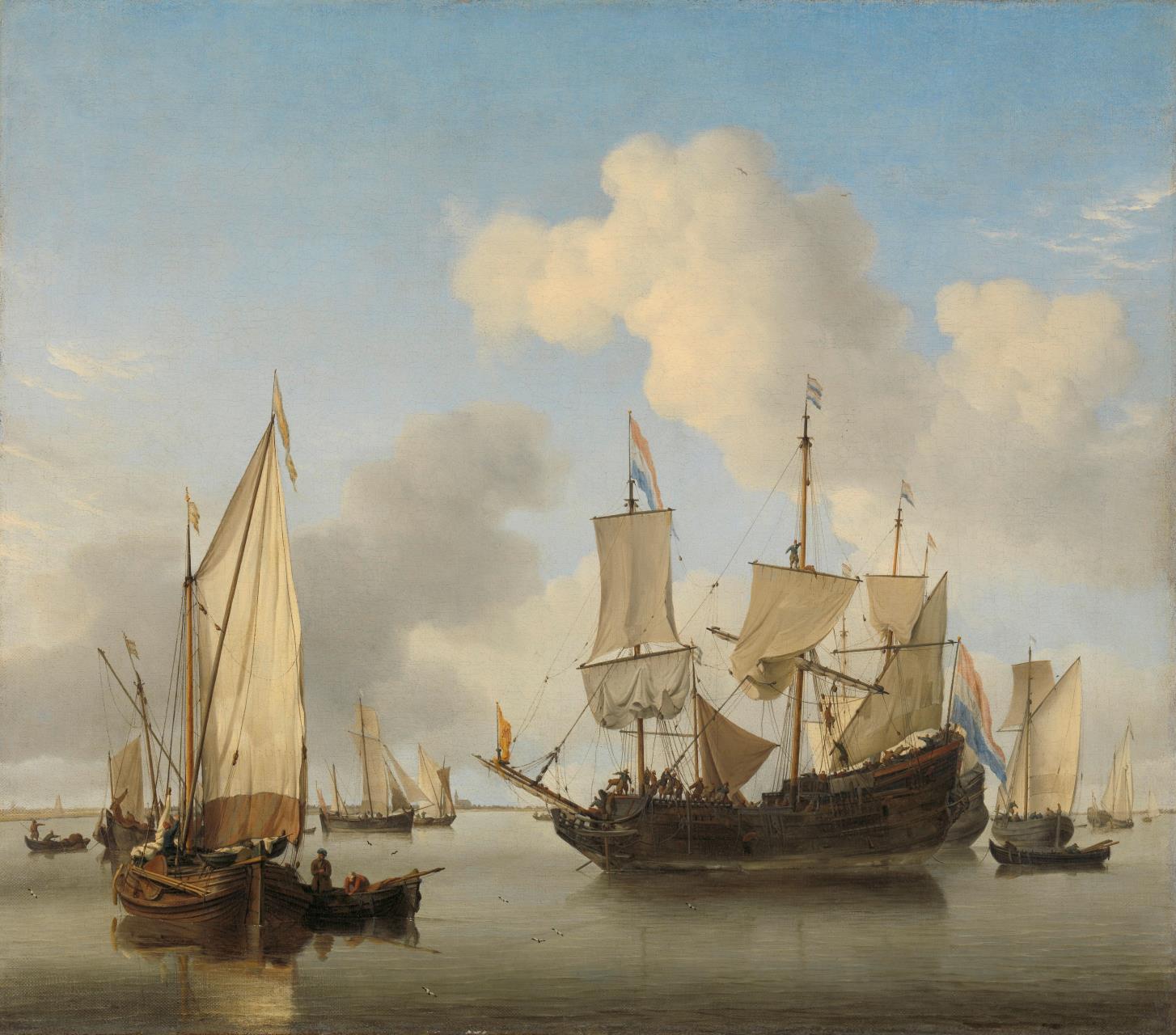Shipwrecks
There have been some 14 known ships wrecked off the Shire of Gingin coastline including the famous Dutch East India Company ship, the 'Vergulde Draeck' (the 'Gilt Dragon'), which went down off the coast between Ledge Point and Seabird in 1656.
Below is a diagram mapping those ships wrecked off the Gingin Shire coastline:

| 1 ~ Vergulde Draeck, 1656 |
8 ~ Grace Darling, 1914 |
| 2 ~ Emily, 1868 |
9 ~ SS Venus, 1923 |
| 3 ~ Seabird, 1874 |
10 ~ Seaflower, 1923 |
| 4 ~ Oleander, 1884 |
11 ~ Manakoora, 1946 |
| 5 ~ Villalta, 1896 |
12 ~ Linda, 1950s |
| 6 ~ Ville de Rouen, 1901 |
13 ~ JP Webb, 1951 |
| 7 ~ Hugh Norman, 1910 |
14 ~ Key Biscayne, 1983 |
Vergulde Draeck
|

Vergulde Draeck (1956) would have appeared similar to this unknown Dutch jacht (the largest vessel in centre).
‘Ships at anchor on the coast’, Willem Van Der Velde (II), c. 1660, Rijksmuseum SK-C-245
|
Of all the shipwrecks near the Ledge Point coast Vergulde Draeck, or Gilt Dragon, is indeed an extraordinary one. It was constructed in 1653 as a 42-metre, 260-tonne ‘jacht’ by the Amsterdam Chamber of the Dutch East India Company, or Vereenigde Oost-Indische Compagnie (VOC). It is one of Australia’s most famous shipwrecks and a crucial event in Australia’s early history of European exploration.
In 1956 Vergulde Draeck set sail from the Cape of Good Hope, South Africa for the VOC’s trading headquarters at Batavia (Jakarta), Indonesia.
On the night of 28 April 1656, Vergulde Draeck struck a submerged coral reef midway between what are now the coastal towns of Seabird and Ledge Point.
On board were 193 crew, eight chests of silver coins worth 78,600 guilders of the world’s most important trade coins at that time – Spanish Silver (pieces of eight, pieces of four and pieces of two) – and trade goods to the value of 106,400 guilders.
On the 193 crew, 118 are believed to have perished. The 75 survivors, including the ship’s captain Pieter Albertszoon and the under steersman (second officer) Abraham Leeman, made it to shore. They had with them the ship’s boat, a ‘schuyt’, along with a small amount of provisions and stores washed ashore.
On 7 May 1656, nine days after the loss of Vergulde Draeck, Abraham Leeman and six crew members were dispatched to Batavia to summon help. After a journey of 1,400 nautical miles lasting six weeks with little water, little food and suffering from exposure, they arrived at Batavia.
Almost immediately after Leeman’s return, the search for survivors and cargo of Vergulde Draeck began. Despite several rescue attempts by the VOC over two years, all failed to find any trace of the missing crew.
The wreck was found by five spearfishers on 14 April 1963, and after a period of heavy looting, shipwreck legislation was enacted to protect the site. The site and its associated artefacts are protected by the Commonwealth Underwater Cultural Heritage Act 2018. Its remains lie on a reef 12km SSW of Ledge Point and is an excellent dive site in calm conditions.
More information on this extraordinary part of WA’s maritime history is available from the VOC Historical Society and Western Australian Museum.
Further Information